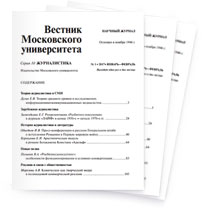The "Eduardo Martins" Case in the Context of Development Problems of Modern Photojournalism: Russian Experts' View
Download paperPhD in History, Associate Professor at the Chair of Photojournalism and Media Technologies, Faculty of Journalism, Lomonosov Moscow State University, Moscow, Russia; ORCID 0009-0008-4058-5732
e-mail: obakulin@yandex.ruSection: Modern Journalism: Subjects and Issues
In September 2017, mass media in different parts of the world reported on the "Eduardo Martins" case. "Eduardo Martins” is a virtual character, whose name is associated with the theft, digital manipulation and distribution through various channels (including publication in mass media and on social networks) of other photographers’ works. Such a resonant case of violation of numerous ethical norms in the digital age brought into focus a large number of issues of modern mass media and photojournalism as an integral part of the media industry. The author was able to collect and analyze various expert comments received from Russian professional photo community members. The analysis showed that the respondents tend to associate the "Eduardo Martins" case primarily with imperfect fact-checking mechanisms and a low level of staff working with visual content. Another significant problem is connected with the insecurity of photographers and their photographic works in the digital space. The findings suggest that there is no consensus among experts on the consequences of the "Eduardo Martins" case for photojournalism and that the majority of respondents do not associate the above-mentioned incident with the crisis of the profession.
DOI: 10.30547/vestnik.journ.5.2019.120134References:
Carlson M. (2009) The Reality of Fake Image: New Norms, Photojournalistic Craft, and Brian Walski’s Fabricated Photograph. Journalism Practice 3 (2): 125–139. DOI: https://doi.org/10.1080/17512780802681140
Guerrero García V., Palomo B. (2015) The Crisis of Photojournalism: Rethinking the Profession in a Participatory Media Ecosystem. Communication & Society 28 (4): 33–48. DOI: 10.15581/003.28.4.33-48
Kobré K. (2008) Photojournalism: The Professionals’ Approach. Burlington: Focal Press.
Kostjukov D. A. (2011) Osnovnye tendencii razvitija sovremennoj fotozhurnalistiki: razmyshlenija fotoreportera [The Main Trends in the Development of Contemporary Photojournalism: Reflections of the Press Photographer]. In V Masterskoj Fotozhurnalista. Sbornik statei [In the Photographer’s Studio. A Collection of Articles]. Moscow. Pp. 133–145.
Lester P. M. (2015) Photojournalism: An Ethical Approach. London: Routledge. DOI: https://doi.org/10.4324/9781315682518
Levshina O. N. (2017) Ideja “self-made man”: osobennosti vosprijatija v SShA i Rossii [The Idea of a “Self-Made Man”: Perceptual Characteristics in the United States of America and Russia]. Obshhestvo: filosofija, istorija, kul’tura: 1—3. (In Russian)
Reaves S. (1987) Digital Retouching: Is there a place for it in Newspaper Photography? Journal of Mass Media Ethics 2 (2): 40—48. DOI: https://doi.org/10.1080/08900528709358293
Reaves S. (1991) Digital Alteration of Photographs in Consumer Magazines. Journal of Mass Media Ethics 6 (3): 175—181. DOI: https://doi.org/10.1207/s15327728jmme0603_5
Reaves S. (1995 а) The Unintended Effects of New Technology (And Why We Can Expect More). Visual Communication Quarterly. Summer: 11—24. DOI: https://doi.org/10.1080/15551393.1995.10387527
Reaves S. (1995 b) The Vulnerable Image. Categories of Photos as Predictor of Digital Manipulation. Journalism & Mass Communication Quarterly 72 (3): 706—715. DOI: https://doi.org/10.1177/107769909507200319






